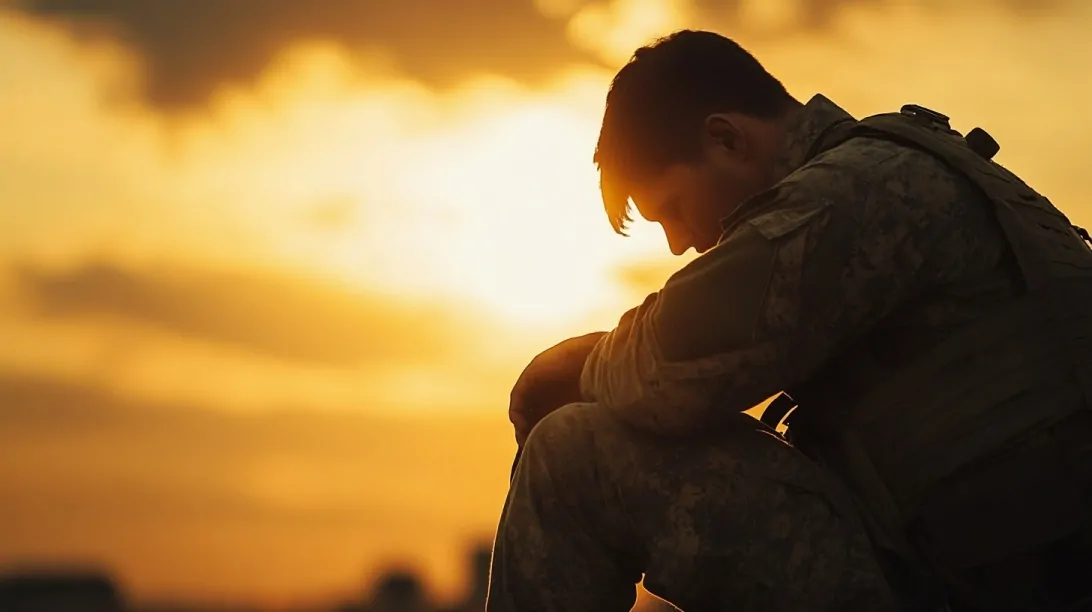Post-traumatic stress disorder (PTSD) is a significant issue in the veteran community. Nationwide, about 7% of U.S. veterans will experience PTSD at some point in their lives, slightly higher than the ~6% lifetime prevalence in the general adult population, according to ptsd.va.gov.
Female veterans are affected at disproportionately higher rates – roughly 13% of women veterans have had PTSD, compared to about 6% of male veterans Military service era plays a major role: veterans who served in recent conflicts report higher PTSD rates than those from earlier eras.
For example, among U.S. veterans surveyed in a large VA study, about 15% of Iraq and Afghanistan (OIF/OEF) veterans had PTSD in the past year, versus 5% of Vietnam War vets and 2% of World War II/Korea vets.
Lifetime prevalence shows a similar pattern – nearly 29% of OIF/OEF veterans have had PTSD at some point, compared to 10% of Vietnam veterans and 3% of WWII/Korean War veterans. These differences likely reflect the intensity of combat exposure and types of trauma in different wars.
Notably, veterans who utilize VA healthcare services have higher diagnosed PTSD rates (about 23% lifetime) than those who do not use VA care (7% lifetime), partly because the VA actively screens for PTSD and military sexual trauma (MST) in patients. MST is another contributor to PTSD: about 1 in 3 women veterans and 1 in 50 men have reported MST when screened, and MST-related trauma is strongly linked to developing PTSD.
Table of Contents
TogglePTSD Hits Veterans Harder Than Civilians — Especially Some Groups
Let’s start with the basics. PTSD is more common in veterans than in the general U.S. adult population. Roughly 7% of veterans will experience PTSD at some point, compared to about 6% of all adults.
- Women veterans: About 13% have had PTSD — more than double the rate in male veterans.
- OIF/OEF veterans (Iraq and Afghanistan): Nearly 29% report lifetime PTSD.
- Vietnam veterans: About 10%.
- World War II and Korean War veterans: Closer to 3%.
Military sexual trauma (MST) also plays a big role here. A third of women veterans and 1 in 50 male veterans report MST, and it’s strongly linked to PTSD. Those using VA healthcare are more likely to be diagnosed, not necessarily because they’re more at risk, but because the VA routinely screens for trauma symptoms and MST.

PTSD Prevalence by State in the Veteran Population (estimated % of veterans with PTSD):
PTSD prevalence among veterans varies across different U.S. states. The table below shows an estimated percentage of veterans in each state who have PTSD. These figures, while approximate, highlight regional differences in veteran PTSD rates:
| State | % with PTSD |
|---|---|
| Alabama | 6.7% |
| Alaska | 9.9% |
| Arizona | 6.4% |
| Arkansas | 5.0% |
| California | 5.7% |
| Colorado | 6.1% |
| Connecticut | 4.6% |
| Delaware | 4.9% |
| District of Columbia | 7.5% |
| Florida | 5.3% |
| Georgia | 6.0% |
| Hawaii | 3.8% |
| Idaho | 6.8% |
| Illinois | 4.6% |
| Indiana | 5.3% |
| Iowa | 5.2% |
| Kansas | 4.9% |
| Kentucky | 5.2% |
| Louisiana | 6.0% |
| Maine | 4.7% |
| Maryland | 5.1% |
| Massachusetts | 3.9% |
| Michigan | 5.0% |
| Minnesota | 4.8% |
| Mississippi | 7.5% |
| Missouri | 5.9% |
| Montana | 8.1% |
| Nebraska | 6.2% |
| Nevada | 6.2% |
| New Hampshire | 4.2% |
| New Jersey | 4.4% |
| New Mexico | 8.8% |
| New York | 4.6% |
| North Carolina | 5.7% |
| North Dakota | 7.0% |
| Ohio | 5.0% |
| Oklahoma | 6.3% |
| Oregon | 5.1% |
| Pennsylvania | 5.7% |
| Rhode Island | 3.9% |
| South Carolina | 6.9% |
| South Dakota | 7.3% |
| Tennessee | 5.3% |
| Texas | 6.3% |
| Utah | 5.2% |
| Vermont | 4.2% |
| Virginia | 5.0% |
| Washington | 4.9% |
| West Virginia | 6.9% |
| Wisconsin | 4.9% |
| Wyoming | 8.3% |
Looking at the table, states in the Western U.S. generally report higher PTSD rates among veterans, while many New England and Mid-Atlantic states show lower rates. For instance, Alaska, New Mexico, Wyoming, and Montana top the list with an estimated ~8–10% of veterans experiencing PTSD, significantly above the national veteran average of ~7%, according to the bridgecareaba.com.
In contrast, states like Hawaii, Massachusetts, Rhode Island, New Jersey, and Connecticut report veteran PTSD prevalence around 4–5%, the lowest in the nation. Most other states fall in the middle range (around 5–7% of veterans with PTSD). It’s important to note these are broad estimates; diagnostic practices and survey data can influence the reported rates. Nonetheless, the geographic pattern is evident.
What’s Behind the State-to-State Differences?

There’s no single answer, but a few key patterns stand out.
1. Veteran Demographics
States with more post-9/11 vets (think: Alaska, New Mexico, Wyoming) see higher PTSD rates. Younger veterans, especially those who saw combat or served multiple tours, are much more likely to carry psychological trauma than older, peacetime veterans, according to the Mission Roll Call.
2. Access to Mental Health Care
In remote or rural areas, VA facilities are few and far between. Telehealth is helping bridge that gap, but broadband access is still spotty in places like rural Alaska. Even when vets want care, it’s not always available nearby.
3. Stigma and Culture
In some communities, especially tight-knit rural or traditional ones, there’s still a strong “tough it out” mentality. That attitude can discourage people from talking about mental health or seeking help — and PTSD goes untreated.
4. Screening and Reporting Practices
Some GOV sources note that VA-heavy states (like Massachusetts or Rhode Island) may be catching more cases early or offering better support. Others might have underreporting due to cultural or logistical barriers.
Veteran Suicide Rates: National Overview

Hand in hand with PTSD prevalence, the issue of veteran suicide has garnered national attention due to its alarming rate. Across the United States, veterans die by suicide at a significantly higher rate than the general population. In 2020, the VA reported that the age-adjusted suicide rate among U.S. veterans was about 57% higher than for non-veteran adult.
American Addiction Center puts things differently, veterans are roughly 1.5 times more likely to die by suicide than their civilian peers, after adjusting for age and sex differences. Female veterans face an even greater relative risk: the suicide rate for women veterans is about 2.5 times higher than for women who never served. (This is partly because civilian women have a low overall suicide rate, making the veterans’ rate disproportionately high by comparison.)
In absolute terms, the numbers are stark. In the most recent annual data, 6,146 U.S. veterans died by suicide in 2020, which averages to about 16.8 veteran suicides per day. The VA’s 2024 report (with updated figures) noted an average of 17.6 veteran suicides per day in 2022, indicating the rate has not substantially declined.
By contrast, the general U.S. population (adults) sees roughly 131 suicides per day, meaning veterans (who make up only ~7% of the population) account for around 13–14% of all suicides nationwide. One analysis even noted that, including certain groups, veterans may comprise nearly a quarter of suicide deaths in America, underscoring the outsized impact of this crisis.
The suicide rate per 100,000 individuals further illustrates the gap. In 2021, the unadjusted suicide rate among veterans was 33.9 per 100,000, compared to about 16.7 per 100,000 for U.S. non-veterans. This means that in a given year, roughly 34 out of every 100,000 veterans died by suicide, double the rate in the civilian community.
In fact, the suicide rate for veterans under 35 rose by 95% over two decades, as noted by some government sources, reflecting the challenges faced by many post-9/11 servicemembers transitioning to civilian life. Middle-aged veterans (35–54) and older veterans (55–74) also saw increases (58% rise for age 55–74 from 2001–2020), though there was a slight downturn in older veteran suicide in the most recent years.
Veterans over 75 have a lower suicide rate than younger adults, but still higher than same-aged civilians.
It’s important to acknowledge the methods and risk factors involved, as they shape prevention efforts. According to some research, striking ~71% of veteran suicides are completed with firearms, a proportion higher than among civilians (about 50%).
Firearm access and safe storage are thus critical issues in veteran suicide prevention. Mental health conditions – especially PTSD, depression, anxiety, and substance use – are common in veterans who die by suicide. For example, one VA analysis found that nearly 2 in 5 veterans who died by suicide had a mental health or substance use diagnosis on record.
Other factors like traumatic brain injury (TBI) and chronic pain also elevate suicide risk in veterans. It’s noteworthy that about 3/4 of veterans who die by suicide are not recent VA health care users (according to earlier VA reports), meaning many at-risk veterans may not be engaged with the very services designed to help them, according to the news.va.gov.
This has prompted the VA to broaden outreach through initiatives like the Veterans Crisis Line (dial 988, press 1) and community partnerships.
Veteran Suicide Rates by State

Just as PTSD prevalence varies by state, so do veteran suicide rates. The table below shows the veteran suicide rate per 100,000 population for each state (based on the latest available VA data, circa 2021). This rate is the number of veteran suicides in a year per 100,000 veterans living in that state, and it is an important metric for comparing the magnitude of the issue across states:
Veteran Suicide Rate by State (per 100,000 veterans) – Age-adjusted rate, 2021:
| State | Veteran Suicide Rate (per 100k) |
|---|---|
| Alabama | 35.4 |
| Alaska | 37.7 |
| Arizona | ~34 |
| Arkansas | ~33 |
| California | ~21 |
| Colorado | ~40 |
| Connecticut | ~20 |
| Delaware | ~28 |
| Florida | ~31 |
| Georgia | ~34 |
| Hawaii | ~20 |
| Idaho | ~45 |
| Illinois | ~25 |
| Indiana | ~30 |
| Iowa | ~30 |
| Kansas | ~35 |
| Kentucky | ~33 |
| Louisiana | ~27 |
| Maine | ~35 |
| Maryland | ~26 |
| Massachusetts | ~18 |
| Michigan | ~30 |
| Minnesota | ~30 |
| Mississippi | ~30 |
| Missouri | ~34 |
| Montana | 51.2 |
| Nebraska | ~28 |
| Nevada | ~45 |
| New Hampshire | ~33 |
| New Jersey | ~17 |
| New Mexico | 46.9 |
| New York | 19.3 |
| North Carolina | ~32 |
| North Dakota | ~ Forty+ (est.) |
| Ohio | ~28 |
| Oklahoma | ~45 |
| Oregon | ~40 |
| Pennsylvania | ~25 |
| Rhode Island | ~19 |
| South Carolina | ~35 |
| South Dakota | ~40 |
| Tennessee | ~30 |
| Texas | ~29 |
| Utah | ~40 |
| Vermont | ~30 |
| Virginia | ~27 |
| Washington | ~30 |
| West Virginia | ~40 |
| Wisconsin | ~30 |
| Wyoming | ~84* |
Several clear patterns emerge from this state-by-state breakdown. First, there is tremendous variability: the highest recorded veteran suicide rates are four to five times greater than the lowest rates. For example, in recent data, New Jersey’s veteran suicide rate was around 17–19 per 100,000 – the lowest in the nation, and significantly below the national veteran average of 33.9.
In contrast, states like Montana (~51.2) and New Mexico (~46.9) had veteran suicide rates well over 40 per 100k. Wyoming appears to have an extremely high rate (one report put it above 80 per 100k) due to its very small veteran population and number of suicides. Generally, many
Western and rural states have elevated veteran suicide rates. These include Montana, New Mexico, Wyoming, Utah, Idaho, Nevada, Oklahoma, West Virginia, and others in the Mountain West and South.
Real Change Requires Real Connection
At the end of the day, PTSD and suicide prevention aren’t just about clinics and data. They’re about relationships, community, and trust. A veteran is far more likely to seek help if someone they know and respect — another vet, a peer, a spouse — tells them, “Hey, I’ve been there. You’re not alone.”
That’s why peer programs are making such a difference. That’s why outreach matters. That’s why it’s not enough to build a system — we have to make sure veterans know that the system is for them, and that help is not only available but encouraged.

Methoodlogy
To craft this article, we began by collecting and analyzing the most recent, credible data from the U.S. Department of Veterans Affairs, the CDC, and leading veteran-focused organizations. We segmented the data by service era, gender, and geographic location to highlight meaningful patterns in PTSD and suicide prevalence.
A state-by-state comparative analysis was created using age-adjusted rates to identify where veterans face the highest and lowest risks. We then contextualized those numbers by examining contributing factors such as healthcare access, rurality, stigma, and socioeconomics.
From there, we highlighted national and local initiatives working to reduce these burdens, emphasizing real-world programs making a measurable impact. Finally, we grounded the data in human connection, reinforcing that numbers alone don’t save lives, but people, policy, and outreach do.
Final Thoughts
PTSD and suicide are two of the most urgent challenges facing America’s veteran community. They cut across every age, gender, and state line. And while national averages tell one part of the story, the local view shows just how varied, and solvable, these challenges can be.
Some states are showing that it’s possible to turn things around. Others still have a long road ahead. But in every part of the country, there’s work being done by VA staffers, by peer mentors, by non-profits, and by veterans themselves to move the needle in the right direction.
The goal isn’t perfection. It’s progress.
Related Posts:
- The Rise of Suicide Rates in US - What 2024 Data…
- PTSD Treatment Success Rates and Therapy Trends in…
- How Lighting Affects Mental Focus, Sleep, and Eye Health
- 8 Eye-Opening Statistics on Mental Health Disorders…
- Updated National Survey Data on Unmet Mental Health…
- Federal Guidelines for Both Aerobic and…








